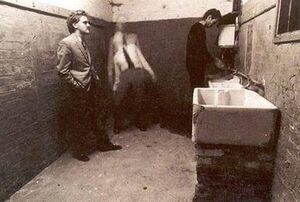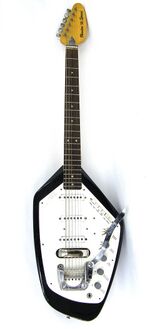Ny Støj
| Ny Støj | |
|---|---|
 Ekkomog promotional photo 1978 | |
| Other names | New Noise, Post-Regnhavn Scene, New Wave |
| Stylistic origins | Punk, Hard bop, Avant-garde music, Art rock, Dub music, Noise rock, Funk, Rhythm and Blues |
| Cultural origins | Late 70's Lyngaard |
| Derivative forms | New Dance, Bølge, Alt-Punk, Art Punk, funk rock, Twee Rock, Indie Rock, Power Pop, Synthpop. |
| Local scenes | |
| Regnhavn Fyrhøgh Tjehåtjen | |
Ny Støj (lit. "New Noise") is a term used to describe a style that evolved at the end of the Punk Rock scene in Regnhavn and Fyrhøgh in the late 70's and early 80's. In the aftermath of the Lyngaardian Punk Scene, typically placed at the Klubgade Riots musicians sought to find new sounds, departing from punk's anti-beauty and raw simplicity. Adopted Avant-Gard sensibilities that helped to evolve their musicianship. Many Arch-punks like Kurt Meldahl of Nærstrid, and Hans Søren Jolicoeur of Lægerne would form Kunst i Bevægelse, which introduced elements of Dub, and Jazz while maintaining the short and sweet song writing and confrontational nature of punk music. Becoming the start of the Ny Støj movement. Other bands would draw from other inspirations, Ekkomog would incorporate influence from Rhythm and Blues music. Børnesoldater would take the incendiary politics of punk and meld them with funk influenced rhythm sections.
Ny Støj would be known for its willingness to incorporate an experiment. Musicians employing affected guitars, newly available synthesizers, Drum Machines, and new studio techniques to create new layered music that build upon the tendencies established by punks in the 60's and 70's. It would also expand on the cultural commentary of punk. Tackling subjects like Politics, Post-Modernism, and more to create a pastiche that reflected the socio-political climate of the era. Ny Støj artists would also continue the DIY tradition, establishing Independent Record Labels, Open Venues, and numerous art collectives. Influencing music abroad in places like Arcadia, The Libertines, and Donnan.
Important early Ny Støj groups include Kunst i Bevægelse, Krigsbrud, Ekkomog, Kvindes Kranium, Spænding, Offentligt Billede, Børnesoldater, Mit livs Spøgelse, and Ødelagte Varer. The movement was closely connected to other developing scenes like New Romantic, Industrial Music, and New Pop. By the late 80's the movement had dispersed, but it helped to spur on the careers of other artists and laid the groundwork for a slew of new genres to come out of the era. Giving way to the massive Independent music scene of the 90's and 00's and continuing to influence popular music today.
Definition and Characteristics
Ny Støj is not so much a specific genre but a broad definition to describe bands and music that came out of the Punk Rock milieu of the 70's. Artists who occupied this space wished to break away from the youthful angst and sneering immaturity of Punk in order and create something more refined. It takes a more opaque poetic approach to lyricism, utilizes Funk, R&B, and Dub/Reggae beats and rhythms and couples them with affected guitars that either cut through the fat of the rhythm section or build upon it depending on the musicians. It rejects Punk's dogmatic ideals in favor of introspection and more mature socio-political narratives. Ny Støj was also notable for its embrace of new instruments and sounds, incorporating new Synthesizers, Sticks, Drum machines, and Analog sequencers
Early Development
Even early in the of the Lyngaardian punk scene we saw attempts at fusion and progression. in the aftermath of the Second Lyngaardian Civil War and the following Industrial Revolution led to a series of immigration waves. Notably from places like The Libertines, Guaimaria, Vailleux, and Cyrenia. Bringing along their musical traditions. In the 50's a musical revolution was occuring as recording and pressing records became cheaper and more practical. This led to the devlopment of R&B, Reggae, and Blues which developed seperate from but always influnced and connected to its origins in The Libertines and Arcadia. Jazz was also coming into its own between the 40's and 50's with Lyngaardian artists specializing in a more abbrassive and angular approach that pulled extensively from other musical traditions. Anders Colucci would pull extensively from his Mauro-Tramontino roots, playing with drummer Hans Gersch they would release Rent Vand in 1958 becoming a early international hit.
Immigrant youth, born and raised in Lyngaard would soon move away from the traditional sounds of their parents' homelands. This noted the transition of Reggae into Dub. with artists like Erin Evers and Hans Anders Wheatly expanding on Reggae's foundations and bringing in more musical variety from influences present at the time. Producers like Erik Linnet, and Kristoff Nøhr would be instrumental in forming the new Dub Sound, and would later be key in helping to form the sounds of many Ny Støj bands. Funk Artists like Stary Jones, Micky Maurdount, Lev Averbuch, and Alesso Trebbi would also be extremely influential. Especially Lev Averbuch's melodic playing and Stary Jones's percussiveness informed many bassists to come.
The venues who would host Punk shows were also some of the only places where formative Dub, Funk, and Blues bands could perform regularly. They also were popular stops for Arcadian prog rock and Hard rock. This musical milieu saw the first fusions as early as 1974 when Punk Band Fortøjet recruited drummer Mads Fredrick after their original drummer Oli Hinkle died of an overdose earlier that year. Fredrick's frenetic drumming, using choppy snare kick patterns would inform D-Beat and Funk Rock. However the Punks had a tendency towards puritanicalism, not including those on the political right who opposed cultural mingling and openly maligned the presence of immigrant musicians as a whole.
in 1973 Punk bands Nærstrid, and Lægerne would play a series of shows at Lydhave Musikklub. Nærstrid guitarist Kurt Meldahl, and Lægerne vocalist Hans Søren Jolicoeur would strike up a friendship. along with them would be Dub band Påske who would play alternating nights at Lydhave. Their Bassist James Taylor would meet Meldahl and Jolicoeur. The crew became friends and requested to play joint shows on Thursdays. By early 1974 Nærstrid, and Lægerne would dissolve over increasing artistic disagreements amongst the members. Maldahl and Jolicoeur would meet up, they would ask James Taylor to join their new project, which he agreed to. two months later they would recruit drummer Therkel Schønfeld from the Punk Band Slagge, forming Kunst i Bevægelse. The band would be the first to formally take on the fusing sounds of the punk scene and make it their own, Taylor's melodic bass playing would cut through the Maldahl's chord heavy guitar. Jolicoeur would often be described as a "Crooner" and a vocal style more influenced by Blues and Rock contemporaries, Jolicoeur would site Jazz Vocalist Lau Hansen and Blues singer Leon Alderson as key inspirations for his transition from a yelpy punk screamer. Kunst i Bevægelse would be seen as the first derivative of punk that could be considered Ny Støj, as opposed to punk bands doing one off experiments.
Regnhavn
Regnhavn is known as a hard-nosed working class city, its punk scene reflected this. The Ny Støj music that came out of the scene was more abrasive and continued the in-your-face approach of punk music. The first Ny Støj bands to emerge took more from global influences particularly amongst immigrant original musical scenes that occupied the music halls at the time. Solen's 1975 song Hvad Vil du Gøre Når de Banker På? brought the political insight that punk had fostered and incorporated reggae and Dub influences. The lyrics commenting on the recent Adams Musiksalen Raid where police raided a music hall frequented by Mauro-Lyngaardian dockworkers. However political iconoclasm was not the only way many found success in the Regnhavn scene. Trojkaen 1976 release Virksomhedsferie saw many of the same influences that affected Solen come through. with songs tackling the First Asemese Civil War, the treatment of Indiginous people in Lyngaard and Donnan, and the Bank Holiday Scandal. However it was the song Jeg Tror jeg Elsker Dig that became the bands iconic single. with its introspective lyrics about a romance that frontman Nick Rourke had just before recording the album. Bands like Vidner om Fortiden, and Kastaniealleen would continue this specific trend of rock music. bringing in more world music influences.
Kristoff Nøhr's Fabrik Records had made a name for itself as an important distributor of Dub Music in the city. But as Dub's influence started to wane he started looking for a new direction to bring the record company. He would form relations with the newly emerging Ny Støj scene and invite bands to start recording singles and Extended play's. His first artistic partnership would be with the band Tråd. Frontman Svend Mørch would form a close collaborative partnership with Nøhr, ultimately producing the bands first LP Uhyggelighedsudstilling in the summer of 1976. The album did middling sales but was an instant cult classic and was beloved critically with the album being number 1 or within the top 5 albums of the year lists for most music press in the country. A string of successful albums out of Fabrik Records, to include Cenotaph by Ekkomog, Typisk Pige by Børnesoldater, and Kultiske Afvigelser by Spænding.
Fyrhøgh
1978-1984
Post-1984



